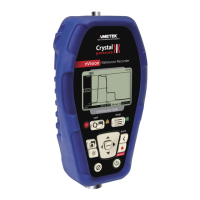(d) Install your RTD sense element wires as appropriate for your conguration (see illustration below), and tighten the set screws.
(e) Conrm correct orientation of element wires in connected state.
2-wire 3-wire 4-wire
4 Lubricate o-ring and thread system with Dow 111 or equivalent in location near terminal block as required to prevent water intrusion when connector shell
is installed. Thread shell in place until tight.
5 Leak check to ensure water tight seal. If any leaking occurs, rework and lubricate as necessary. If leak-free, your RTD sensor is ready to use with the nVision
Reference Recorder.
Note:
Your nVision has the RTD100 module TCR set to Pt100 (385) Euro. Modify this setting in CrystalControl as needed.
Modifying the Base Resistance (Ro)
As with any measurement device, it is possible the sensor will drift over time or from extreme temperatures. The nVision allows a user dened oset to the
100Ω base resistance experienced at 0ºC if needed to improve the performance of your sensor.
Dierential Temperature
The Tare function also allows you to equalize the dierential temperature or resistance measurements to improve your measurement accuracy. Therefore,
if you apply the same temperature or resistance signal to both RTD100 sensor elements simultaneously you should have a ΔT reading of zero. Due to the al-
lowable error tolerance for each module, the reading may not be zero. The Tare function allows you to normalize both of these readings so that the ΔT reading
is z
er
o. Therefore, you will have a much more accurate ΔT reading than you normally would have if this process was not completed. Note that generally ac-
cepted lab practices should be followed when trying to establish a common temperature measurement on two independent sensors.
T
he
Tare should be reestablished every time you are at a new temperature or resistance. For instance if your ΔT reading has 0.2°C of Tare at 220°C, when you
return to ambient conditions this 0.2°C of Tare will remain in place on your ΔT reading until cleared with the button.
Dierential Temperature Measurement Uncertainties without Tare
The RTD100 module is capable of both temperature and resistance measurements. The resistance measurement uncertainty can be calculated by
combining the uncertainties of the two resistance measurements. The following formulas describe the combined uncertainty of two RTD100 Module
resistance measurements.

